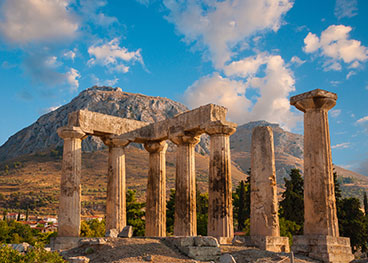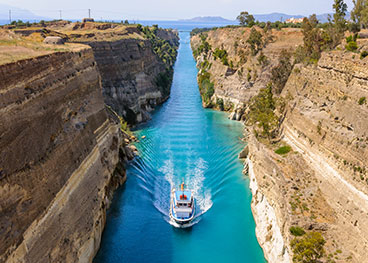Korinthos

The prefecture’s capital is the region’s prominent administrative, commercial, financial and cultural centre. The city centre has wide roads, parks, squares and a picturesque port with fishing boats. Beautiful pedestrian walkways entice the visitors for a stroll, a coffee and shopping, with monuments, museums and historical sites surrounding the city.
The settlement
The settlement dating to 5000 B.C that was discovered in the Korakos region is testament to Korinthos’ habitation since the Neolithic Age. In antiquity Korinthos was one of the largest and most important cities in Greece. It played a significant part during the Peloponnesian War and after 200 B.C it became the capital of the Achaean Confederation. Under Julius Caesar it was elevated to the capital of the Achaia province. During the middle Ages it was associated with its impressive fortifications at Akrokorinthos (Acrocorinth). A powerful earthquake destroyed the city in 1858, which was rebuilt with good earthquake resistant specifications on a good town plan, 9 km to the north of the ancient city. The charming town of Palaia Korinthos is situated on the site of Ancient Korinthos. Korinthos is 84 km to the west of Athens.

Must See attractions
- The seaside zone, especially around the El. Venizelos square with the impressive statue of Pegasus and the small port of Floisvos with the marina. Close by, you will find Kalamia, an extensive and established pebble strewn beach, with many coffee shops and taverns all along it.
- The pedestrian walkway on Pilarinos Zografos Street is a much frequented meeting place for the residents with stores, coffee shops and bars.
- The central Perivolakia square – park with the coffee shops and restaurants is the ideal location for stopping and resting. Across the road (on Ethnikis Antistasis Street) is the city’s impressive Court House, while the statue of Archbishop Damascenus (1890-1949) stands at the small square precisely in front of the Courts.
- The Apostolos Pavlos (Apostle Paul) metropolitan church, on the street of the same name, which was built after the 1928 earthquakes. The “Apostle to the Nations” lived and taught here for a short period and is the city’s patron saint.
- The Historic-Folklore Museum (close to the El. Venizelos square), with exhibits of 3,500 18th and 19th century costumes from all over Greece.
- The Ecclesiastical Museum was established in 1973 and contains significant ecclesiastical exhibits (manuscripts, high priest vestments, portable icons, gospels, photographs etc).
- The Municipal lending Library (84 Pilarinos Street), with notable collections and the Municipal Art Gallery (4 Kolokotroni Street).
Near By attractions
- The archaeological site of Ancient Korinthos is 9 km north-west of the modern city. You can see the ruins at Pirini fountain, the courtyard of Apollo, the foundations of a significant Roman basilica, the temple of the goddess Tyche (Fortune) or Apollo Klarios, the stores in the agora, the temple of Apollo, the ruins of the theatre and the Lerna fountain. The town of Acrocorinth, at whose foot the ancient city was built, dates to circa 4000 B.C. The Archaeological Museum operates at the archaeological site (built in 1931-32) with an exhibition collection dating from the Prehistoric Period through to the Roman and Byzantine Period. It is worth seeing the large Mycenaean crater (vessel) (circa 1200 B.C.), the Corinthian amphora and stopper (600 B.C.) etc
- Acrocorinth (the residence of the Sun God!), 3.5 km south of ancient Korinthos, at the peak of a 575 m high hill, has always been the fortified acropolis of Korinthos. It is the oldest, largest and most impressive castle in the Peloponnese, whose walls were built during the middle Ages. It is worth seeing the ruins at the temple of Aphrodite, and the relics of the Christian Churches and the Turkish buildings, on the peak of the hill. In addition to its archaeological significance, Acrocorinth is a rich botanical garden with numerous indigenous Greek wild flowers and belongs to the “Natura 2000” European Union habitat network. On the opposite hill (Penteskoufi) there is a smaller medieval castle (13th century), which is however difficult to access.
- The Corinthian Canal: the idea for the canal, which connects the Saronic to the Corinthian gulf, was conceived by Periander (6th century B.C.); however, the canal was finally opened after Greece’s independence, during the period 1882-1893. It has a length of 6,346 metres, a width of 24.6 metres at sea level and a depth of 8 metres.
- Possidonia (on the western side of the canal, close to the Corinthian gulf), where you can see the Ancient Passage Way (Diolkos). It is a paved road that was constructed due to the need for rapid passage by ships from the Saronic to the Corinthian gulf and vice versa. It was constructed in the early 6th century B.C. and is associated with Periander’s tyranny in Korinthos. Its western edge was reconstructed in the early 4th century B.C. It was used to transport small (especially military) vessels. This use has been attested by sources down to the 9th century A.D.
- Lechaio is a beautiful seaside town, 8 km to the west of Korinthos. The region was developed in the 6th century B.C, since Lechaio – together with Keghrees – were the city’s two ports. The ruins of the ancient port have survived to the present day. Excavations have uncovered the ruins of a palaeo-Christian basilica, to the west of the ancient port, which was constructed in the 5th century A.D in honour of the martyr Leonidis and the seven Virgins who martyred during the Decian persecution in 251 A.D. The church of Agios Gerasimos is also situated at Lechaio where Gerasimos Notaras was a hermit. There is a fertile valley in the wider region, where fruit and grape vines are cultivated.
Why choose us

We offer High Quality Services through a well trained stuff.

From the minute you submit your quote till the minute your journey ends we are here for you! You can contact us by mail, through live chat or thought or online booking system.

We provide Coach Hire Services for Greece and Europe and our Buses / Coaches offer a wide range of facilities.

There is always an agent available to solve any problem that may take place during your journey.

All our Coaches / Buses are undergoing the appropriate maintenance(services) in order to offer reliable services.

We provide very competitive prices and our sales agents are always trying to provide rates that meet your needs.
